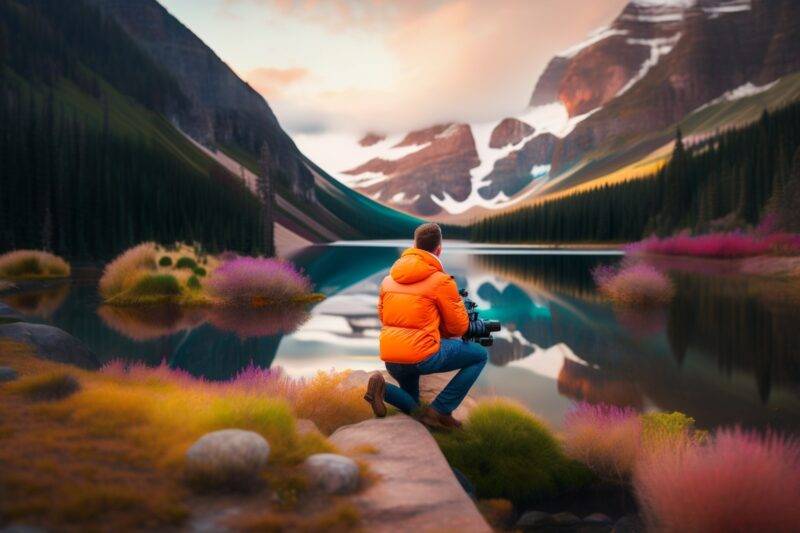Last Updated on June 18, 2023 by PixelPluck
We all have individual styles as photographers. Here I would like to illustrate my idea of How to Create a Sense of Depth in a Photograph. In simple words creating an immersive image.
Capturing a photograph that evokes a sense of depth is an essential skill for any photographer. By creating depth, you can engage your viewers and transport them into the scene, making your images more visually compelling. In this article, we will explore techniques and tips to help you enhance the depth of your photographs, ensuring they stand out and leave a lasting impact on your audience.
Choose the Right Lens
Selecting the right lens is crucial for creating depth in your photographs. Wide-angle lenses, such as 24mm or 35mm, are ideal for emphasizing depth. These lenses allow you to capture more of the scene, expanding the perceived space and enhancing the sense of depth. Additionally, wider lenses tend to exaggerate the distance between the foreground and background elements, enhancing the three-dimensional effect.

Here’s a table that illustrates which lens types can be used to achieve different senses of depth in an image:
| Lens Type | Sense of Depth Achieved | Suitable Photography Subjects |
|---|---|---|
| Wide-Angle | Emphasizes depth | Landscapes, architecture, expansive scenes |
| Ultra-Wide | Exaggerates depth | Grand landscapes, sweeping vistas |
| Telephoto | Compresses depth | Portraits, wildlife, compressed scenes |
| Macro | Close-up depth | Small subjects, details, textures |
| Fisheye | Distorted depth | Experimental, creative, unique perspectives |
Keep in mind that these lens types can also be used creatively to achieve different effects. The table above provides a general idea of the typical uses and effects associated with each lens type, but don’t be afraid to experiment and explore unique combinations to create your own distinctive sense of depth in your photographs.
Utilize Foreground Interest
Incorporating a strong foreground element in your composition is a powerful way to add depth to your photographs. A compelling foreground subject, such as a person, object, or leading lines, draws the viewer’s attention and creates a sense of scale and distance. Experiment with different angles and positions to find the perfect balance between the foreground and the background, ensuring the elements work together harmoniously.
Play with Perspective
Perspective plays a crucial role in creating depth in your photographs. By changing your shooting position or angle, you can alter the perception of distance and space within the frame. Consider getting low to the ground to make the foreground appear more prominent and create a sense of depth by emphasizing the height and distance of the background elements. Similarly, shooting from a higher vantage point can compress the foreground and make the background elements appear farther away.
Utilize Leading Lines
Leading lines are a powerful compositional tool for guiding the viewer’s eye through the image and creating a sense of depth. Look for natural or man-made elements, such as roads, rivers, or fences, that lead into the distance. By incorporating these lines into your composition, you can add depth and dimension to your photographs. Experiment with different angles and positions to find the most effective lines that enhance the overall sense of depth in your images.
Here is an example illustration of how to use the leading lines to bring focus to the subject and create a sense of depth.

Pay Attention to the Depth of Field
Controlling the depth of field is crucial in emphasizing the sense of depth in your photographs. By using a wide aperture (smaller f-number) such as f/2.8 or f/4, you can achieve a shallow depth of field, blurring the background and making the subject stand out. This technique separates the foreground from the background, enhancing the perception of depth and drawing the viewer’s attention to the main subject. Experiment with different apertures to find the right balance between sharpness and background separation.
Consider Atmospheric Perspective
Atmospheric perspective refers to the natural haziness or decreases in contrast that occurs as objects recede into the distance. Utilize this phenomenon to your advantage by incorporating elements such as mist, fog, or distant haze in your photographs. By capturing these atmospheric conditions, you can enhance the sense of depth and distance, adding a layer of realism and intrigue to your images.

Conclusion
Creating a sense of depth in photography is a skill that can significantly enhance the impact and visual appeal of your images. By incorporating techniques such as choosing the right lens, utilizing foreground interest, playing with perspective, using leading lines, controlling depth of field, and considering atmospheric perspective, you can master the art of capturing depth in your photographs. Remember, practice and experimentation are key to refining your skills and developing a unique style that captivates your audience. So, grab your camera, explore different environments, and let your creativity soar as you create breathtaking images with a remarkable sense of depth. This concludes our short intro on How to Create a Sense of Depth in Photograph.